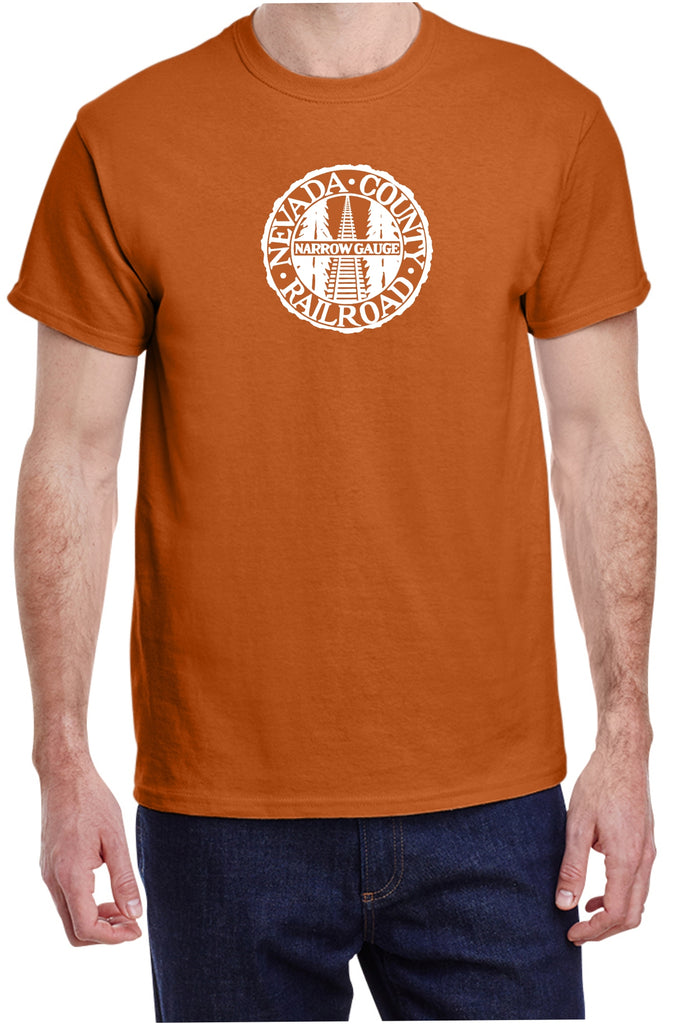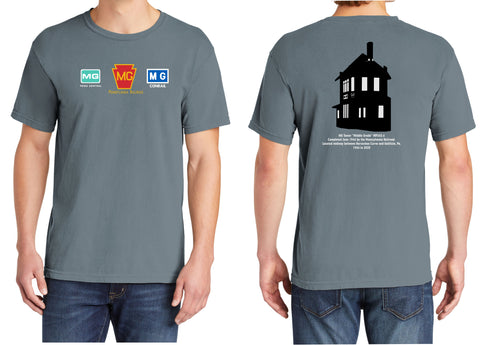
Nevada County Narrow Gauge Railroad Shirt
Nevada County Narrow Gauge Railroad Shirt
- Logo Printed on Front
- 100% Cotton
- Shirt Color - Texas Orange
The Nevada County Narrow Gauge Railroad (NCNGRR) (nickname: Never Come, Never Go) was located in Northern California's Nevada County and Placer County, where it connected with the Central Pacific Railroad.[1] The Nevada County Narrow Gauge Railroad Company incorporated on April 4, 1874,[2] and was headquartered in Grass Valley, California. After two years of construction, passenger and commercial rail services began in 1876 and continued until 1943. The 22.53 mi (36.26 km) line ran from Colfax, north through Grass Valley to Nevada City. At one time, the railroad was notable for having the highest railroad bridge in California, the Bear River Bridge, built in 1908.[3]
The need for rail service in the semi-mountainous and wooded area of Grass Valley and Nevada City was precipitated by mining operations subsequent to the California Gold Rush. In addition, timber operators wanted to make their land accessible to the Southern Pacific Company in Colfax. On March 20, 1874, the California legislature and Governor Newton Booth approved the right to build and operate a 3 ft (914 mm) narrow gauge from Colfax, through Grass Valley, to Nevada City.[4] On June 20, an Act of Congress granted the railroad right of way through public lands.[5]
J. H. Bates estimated that construction and equipment would total $411,132. Only one bid came in and it was for $500,000, signed by M. F. Beatty; he received a lump sum of $500,000. Construction began January 1875.[6] Turton & Knox were subcontracted for earthwork. John Flint Kidder was the chief engineer. Within two months, 600 men were employed in the railroad's construction.[7]
Construction included two bridges, two tunnels,[8] and five trestles. After leaving the Colfax depot, the road headed north, parallel with the Central Pacific Railroad, then crossed Bear River, and into Nevada County. One of the first stations was at the town of You Bet, which serviced the Goodwin Drift Gravel Mine.[9] The road proceeded into Chicago Park, a fruit and grape growers colony,[10] and then continued into Grass Valley. All cars and locomotives had Westinghouse railway brakes, and cars used for passenger service had Miller Platform couplers. As the first contractor, Beatty, was unable to complete the project, a second, J. K. Bynre,[11] was brought in; construction was completed in the spring of 1876. The inaugural train, from Colfax to Grass Valley, ran on April 11 and by May 20, the first train reached Nevada City.[12]
N.C.N.G.R.R. №
The company's first President was John C. Coleman, president of the North Star Mine. Kidder, the builder, decided to settle down in Grass Valley, becoming the General Superintendent,[13] and in 1884, became the second president. Upon his death in 1901, Kidder's widow, Sarah, took over, becoming the first female railroad president in the world.[14]
In September 1907, a 3.56 mi (5.73 km) "cut-off", at a cost of $132,285 was built,[15] bettering the grade.[16] The following year, construction was completed on the Bear River Bridge. By 1912, the NCNGRR was running three mixed trains daily, each way, between Nevada City and Colfax, while a fourth mixed train ran daily, each way, between Grass Valley and Colfax. Sarah Kidder sold her interests in 1913 and retired to San Francisco.
In 1926, Earl Taylor and his associates purchased the railroad for $1. With the outbreak of World War II, they sold it in 1942 for $251,000 to Dulian Steel Products Company and the last train to run over the line was on May 29.[7]
Each combination coach had a small iron safe in the baggage compartment.[17] Though $200,000,000 in gold was hauled out of Nevada County by the NCNGRR during its operation, there was never an attempted robbery.[8]




